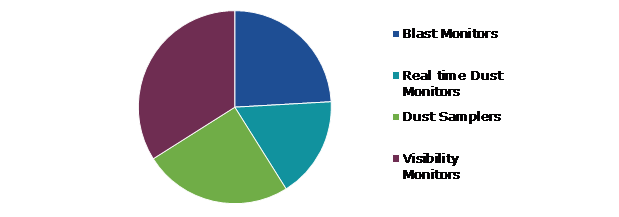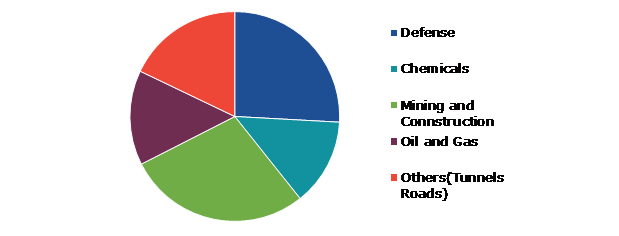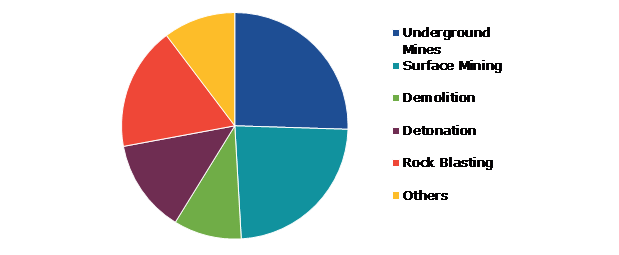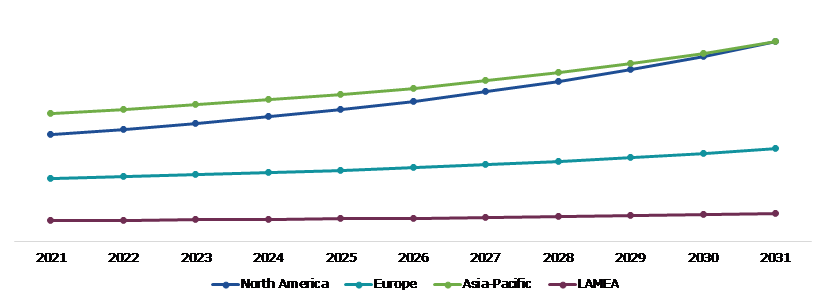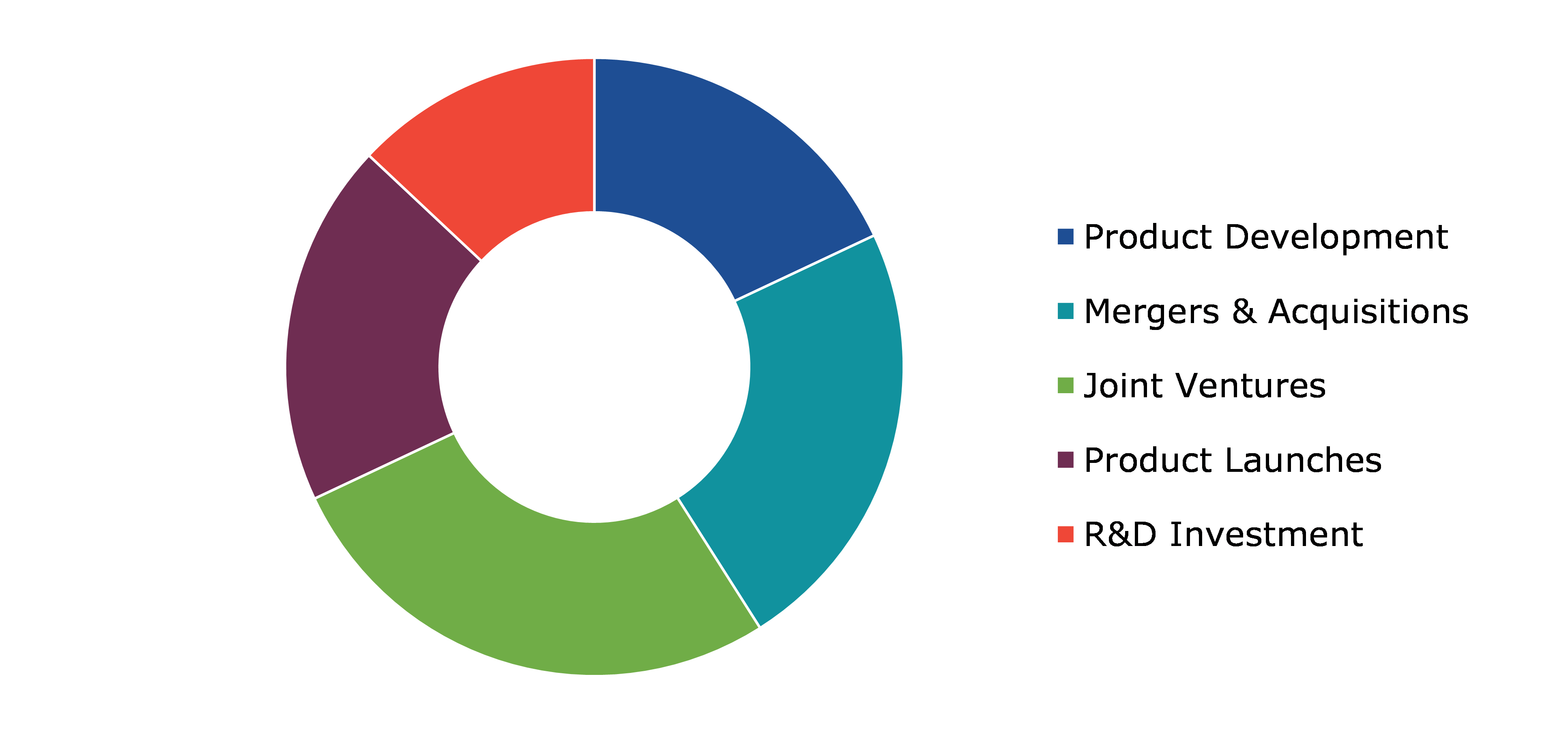Blast Monitoring Equipment Market Report
RA08602
Blast Monitoring Equipment Market by Product Type (Blast Monitors, Real Time Dust Monitors, Dust Samplers, and Visibility Monitors), End-use Industry (Defense, Chemicals, Mining & Constriction, Oil & Gas, and Others), Application (Underground Mines, Surface Mining, Demolition, Detonation, Rock Blasting, and Others), and Region (North America, Europe, Asia-Pacific, and LAMEA): Global Opportunity Analysis and Industry Forecast 2022–2031
Global Blast Monitoring Equipment Market Analysis
The Global Blast Monitoring Equipment Market Size was $253.3 million in 2021 and is predicted to grow with a CAGR of 5.2%, by generating revenue of $412.7 million by 2031.
Global Blast Monitoring Equipment Market Synopsis
Mining companies are opting automated blasting operations using cutting-edge technology to minimize mining costs and increase profit margins. Therefore, service providers have started to include thorough analysis and malicious behavior warnings in their blast monitoring equipment automation service portfolio for blasting operations to support improved mining activity management. Service providers such as Maxamcorp Holding and SL are already delivering personalized services and addressing their clients' demands. On November 14, 2019, Orica Limited and Epiroc Rock Drills AB announced their collaboration to create a semi-automatic explosive delivery system to enable a more productive and safe blasting environment at mining sites.
The mining and construction sectors are the largest users of blast monitoring equipment. During blasting, the blast may increase the dust and noise which is hazardous to human health. When humans breathe in airborne dust while at work, they run the risk of developing what is called an occupational illness. Excessive dust exposure results in sickness, temporary and permanent disability, and high mortality every year in both developed and developing countries. Dust at a blasted place is expected to cause environmental damage, contaminate or degrade products, and even cause fires or explosions.
Blast monitoring equipment is mostly used in the mining industry. Several rules and regulations have been created to improve mine worker safety and reduce the environmental harm caused by mining operations. For example, the Surface Mining Control and Reclamation Act (SMCRA) of the U.S., which strives to reduce harm and damage caused to the public and property, supports the use of more modern blasting technologies. Similarly, Ghana's Minerals and Mining (Explosives) Regulations govern the use, conveyance, possession, and storage of explosives for quarrying, mining, and civil activities. Similar rules have been imposed in a number of countries, including India, Australia, Canada, and the U.S., where mining contributes considerably to the overall national GDP.
Blast Monitoring Equipment Overview
A blast monitoring system is used to measure blasting activity from the mining sites. The most recent blast technology allows mine owners to increase efficiency and free up resources by automating drilling and blasting operations. Miners need to operate in difficult terrain due to the never-ending demand for natural resources, which increases in-ground stress. In order to decrease the time miners spend doing manual tasks and increase mine safety, it is necessary to implement more precise and technologically supported drilling and blasting activities.
COVID-19 Impact on Global Blast Monitoring Equipment Market
The COVID-19 impact on blast monitoring equipment market has caused several uncertainties that have resulted in significant economic losses as many enterprises around the world came to a standstill. There was less need for blast monitoring equipment owing to supply chain disruptions, the closing of manufacturing facilities, and a global economic slump. Mining activities have been resilient in both the Commonwealth of Independent States (CIS) and Africa during the pandemic but have been hampered by quarantine restrictions and mine closures owing to the outbreak. Sea freight expenses for Primary Care Providers (PCP) increased dramatically, during the second wave of COVID-19. Furthermore, the construction and mining sectors were hampered severely in terms of new project sales and acquisition, resulting in a major decrease in demand for blast monitoring equipment.
On January 21, 2020, the Orica company took a new initiative to produce blast monitoring equipment. Orica introduced new underground blast design software to increase productivity and lower costs.
The Significant Increase in Construction Blasting Activities Across the Globe to Drive the Market Growth
The increase in construction blasting activities has significantly resulted in an increase in demand for industrial explosives which is directly related to mining operations. The supply-demand imbalance for commodities such as coal (for power generation), limestone (for cement manufacturing), iron ore (for steel production), and stone aggregates from stone quarries is enormous, particularly in the mining industry (for use in construction and infrastructure projects). Construction activities, such as blasting and pile driving are increasing, as population density rises. These factors are projected to drive the blast monitoring equipment market growth during the forecast period.
To know more about global blast monitoring equipment market drivers, get in touch with our analysts here.
The Dependability Issues With Monitoring System Forecasting Capabilities to Be an Impediment to The Growth of the Market
Experienced operators are frequently doubtful of the diagnosis and forecasts provided by blast monitoring equipment systems due to problems such as blast measurements issue, service outages, and erroneous alerting blast signals caused by the instruments. Furthermore, employees may be averse to the new way of planning and maintaining process efficiency, resulting in a lack of support for the implementation of efficient blast monitoring equipment. Demand for blast monitoring equipment is expected to be hampered owing to the difficulties in manufacturing settings, which may include a variety of surfaces on which blast monitoring equipment and services may be difficult to implement. The sustainability issues related to monitoring system forecasting capabilities are a significant barrier to the industry growth.
Increase in development in blast monitoring technology to drive excellent opportunities in the market
The major advancements in blast technology are expected to drive the demand for blast monitoring equipment which is further projected to drive the market growth. One of the factors driving the market growth is the ongoing shift from cartridge products in favor of bulk products for both surface and underground operations. Surface and underground delivery-vehicle technologies that improve blast accuracy and security, such as high-precision pumps and blending and measurement devices, robotic arms that place the product in the hole, and remote controls, are also contributing factors to the market expansion. These factors are projected to create numerous blast monitoring equipment market opportunities for the key players in during the forecast period.
To know more about global blast monitoring equipment market opportunities, get in touch with our analysts here.
Global Blast Monitoring Equipment Market, by Product Type
Based on product type, the market has been divided into blast monitors, real time dust monitors, dust samplers, and visibility monitors. Among these, the blast monitors sub-segment accounted for the highest market share in 2021, whereas the real time dust monitors sub-segment is estimated to witness the fastest growth during the forecast period.
Global Blast Monitoring Equipment Market Size, by Product Type, 2021
Source: Research Dive Analysis
The blast monitors sub-type accounted for a second dominant market share in 2021. Blast monitoring equipment in mining is an important tool to measure the impact on surrounding structures and the impact on nearby communities when it comes to compliance reporting. Excessive blast overpressure from mining activity or demolition can cause damage to nearby structures as well as complaints from the community. Therefore, blasting can only take place under specific weather conditions and is subject to compliance limits. In June 2018 to help manage the environmental management solutions provider, EMS Brüel & Kjær, added a blast overpressure microphone to its Vibration Monitoring Terminal (VMT). The VMT is an innovative and versatile solution for monitoring ground vibration.
The real time dust monitors sub-type is anticipated to witness the fastest growth by 2031.
The advantages of real-time dust monitoring are the ability to quickly and easily analyze dust controls to determine whether they are operating properly, with an instant result and the option to alter the controls and study the dust levels. Real-time monitoring data can be gathered and tracked to demonstrate before and after improvements. The real-time dust monitor can be used in conjunction with a video camera to visually identify where elevated dust levels occur throughout a work or over the course of a day of monitoring. This data and video footage may be modified using the NIOSH EVADE Software to show the dust levels and locations where the peaks have occurred.
Global Blast Monitoring Equipment Market, by End-use Industry
Based on end-use industry, the market has been classified into defense, chemicals, mining & construction, oil & gas, and others. Among these, the mining & construction sub-segment accounted for the highest revenue share in 2021.
Global Blast Monitoring Equipment Market Share, by End-use Industry, 2021
Source: Research Dive Analysis
The mining & construction sub-segment is anticipated to hold a dominant market share by 2031. Construction equipment is used in the construction of both residential and non-residential structures, such as roads, tunnels, bridges, and buildings & factories. Underground mining, drilling and mineral processing, and surface mining all employ mining equipment. By using mining equipment, it is feasible to reduce labor and eliminate the need for explosives and bursting. Technological developments in the construction and mining sector, enable company owners to complete projects on schedule. These factors are expected to drive the growth of the mining and construction sub-segment during the forecast period.
Global Blast Monitoring Equipment Market, by Application
Based on application, the market has been divided into underground mines, surface mining, demolition, detonation, rock blasting, and others. Among these, the underground mines sub-segment accounted for the highest revenue share in 2021.
Global Blast Monitoring Equipment Market Analysis, by Application, 2021
Source: Research Dive Analysis
The underground mines sub-segment is anticipated to hold a dominant market share by 2031. Underground mining involves the extraction of rock or minerals from the subsurface that cannot be extracted from the surface. Tunnels or levels are constructed by blasting or drilling through the rock to extract the rock or minerals from the earth. Ground vibrations are produced by both blasting and drilling and propagate through the ground away from the source. Vibrations of this magnitude can cause damage to neighboring buildings such as other floors, offices, conveyor systems, and elevator or ventilation shafts. These strong vibrations can also impact structures above ground in more metropolitan situations, such as residences, office buildings, and roadways.
Global Blast Monitoring Equipment Market, Regional Insights
The blast monitoring equipment market was investigated across North America, Europe, Asia-Pacific, and LAMEA.
Global Blast Monitoring Equipment Market Size & Forecast, by Region, 2021-2031 (USD Million)
Source: Research Dive Analysis
The Market for Blast Monitoring Equipment in Asia-Pacific to be the Most Dominant
The Asia-Pacific blast monitoring equipment market accounted for a dominating market share in 2021. The blast monitoring equipment market analysis in Asia-Pacific is growing due to the improved application of blast monitors across manufacturing operations in diverse industrial sectors, as well as the strict regulatory framework regarding workforce security in the expanding mining industry. Rising acceptance of predictive maintenance equipment, competitive pressure to achieve operational competence, expansion of manufacturing activities and low labor costs in the advancing countries within the region are all driving the regional blast monitoring equipment market growth.
Competitive Scenario in the Global Blast Monitoring Equipment Market
Investment and agreement are common strategies followed by the major market players. For instance, on May 02, 2022, Orica, successfully developed the Fortis Protect series of bulk explosives, which will reduce the danger of nitrate leaking during blasting operations.
Source: Research Dive Analysis
Some of the leading blast monitoring equipment market players are Orica, Acoem, ECOTECH PTY LTD, Hexagon AB, Core Lithium, and Maine Drilling and Blasting.
| Aspect | Particulars |
| Historical Market Estimations | 2020 |
| Base Year for Market Estimation | 2021 |
| Forecast Timeline for Market Projection | 2022-2031 |
| Geographical Scope | North America, Europe, Asia-Pacific, and LAMEA |
| Segmentation by Product Type |
|
| Segmentation by End-use Industry |
|
| Segmentation by Application |
|
| Key Companies Profiled |
|
Q1. What is the size of the global blast monitoring equipment market?
A. The size of the global blast monitoring equipment market size was over $253.3 million in 2021 and is projected to reach $412.7 million by 2031.
Q2. Which are the major companies in the blast monitoring equipment market?
A. Orica, Acoem, and Hexagon AB are some of the key players in the global blast monitoring equipment market.
Q3. Which region, among others, possesses greater investment opportunities in the near future?
A. Asia-Pacific possesses great investment opportunities for investors in the future.
Q4. What will be the growth rate of the Asia-Pacific blast monitoring equipment market?
A. Asia-Pacific blast monitoring equipment market share is anticipated to grow at 4.7% CAGR during the forecast period.
Q5. What are the strategies opted by the leading players in the market?
A. Product launch and investment are the two key strategies opted by the operating companies in the market.
Q6. Which companies are investing more on R&D practices?
A. Orica, Acoem, and Hexagon AB are the companies investing more on R&D activities for developing new products and technologies.
1.Research Methodology
1.1.Desk Research
1.2.Real time insights and validation
1.3.Forecast model
1.4.Assumptions and forecast parameters
1.5.Market size estimation
1.5.1.Top-down approach
1.5.2.Bottom-up approach
2.Report Scope
2.1.Market definition
2.2.Key objectives of the study
2.3.Report overview
2.4.Market segmentation
2.5.Overview of the impact of COVID-19 on Global blast monitoring equipment market
3.Executive Summary
4.Market Overview
4.1.Introduction
4.2.Growth impact forces
4.2.1.Drivers
4.2.2.Restraints
4.2.3.Opportunities
4.3.Market value chain analysis
4.3.1.List of raw material suppliers
4.3.2.List of manufacturers
4.3.3.List of distributors
4.4.Innovation & sustainability matrices
4.4.1.Technology matrix
4.4.2.Regulatory matrix
4.5.Porter’s five forces analysis
4.5.1.Bargaining power of suppliers
4.5.2.Bargaining power of consumers
4.5.3.Threat of substitutes
4.5.4.Threat of new entrants
4.5.5.Competitive rivalry intensity
4.6.PESTLE analysis
4.6.1.Political
4.6.2.Economical
4.6.3.Social
4.6.4.Technological
4.6.5.Environmental
4.7.Impact of COVID-19 on Blast Monitoring Equipment market
4.7.1.Pre-covid market scenario
4.7.2.Post-covid market scenario
5.Blast Monitoring Equipment Market, by Product Type
5.1.Overview
5.1.1.Market size and forecast, by Product Type
5.2.Blast Monitors
5.2.1.Key market trends, growth factors, and opportunities
5.2.2.Market size and forecast, by region, 2021-2031
5.2.3.Market share analysis, by country, 2021-2031
5.3.Real Time Dust Monitors
5.3.1.Key market trends, growth factors, and opportunities
5.3.2.Market size and forecast, by region, 2021-2031
5.3.3.Market share analysis, by country, 2021-2031
5.4.Dust Samplers
5.4.1.Key market trends, growth factors, and opportunities
5.4.2.Market size and forecast, by region, 2021-2031
5.4.3.Market share analysis, by country, 2021-2031
5.5.Visibility Monitors
5.5.1.Key market trends, growth factors, and opportunities
5.5.2.Market size and forecast, by region, 2021-2031
5.5.3.Market share analysis, by country, 2021-2031
5.6.Research Dive Exclusive Insights
5.6.1.Market attractiveness
5.6.2.Competition heatmap
6.Blast Monitoring Equipment Market, by End-use Industry
6.1.Overview
6.1.1.Market size and forecast, by End-use Industry
6.2.Defense
6.2.1.Key market trends, growth factors, and opportunities
6.2.2.Market size and forecast, by region, 2021-2031
6.2.3.Market share analysis, by country, 2021-2031
6.3.Chemicals
6.3.1.Key market trends, growth factors, and opportunities
6.3.2.Market size and forecast, by region, 2021-2031
6.3.3.Market share analysis, by country, 2021-2031
6.4.Mining & Construction
6.4.1.Key market trends, growth factors, and opportunities
6.4.2.Market size and forecast, by region, 2021-2031
6.4.3.Market share analysis, by country, 2021-2031
6.5.Oil & Gas
6.5.1.Key market trends, growth factors, and opportunities
6.5.2.Market size and forecast, by region, 2021-2031
6.5.3.Market share analysis, by country, 2021-2031
6.6.Others
6.6.1.Key market trends, growth factors, and opportunities
6.6.2.Market size and forecast, by region, 2021-2031
6.6.3.Market share analysis, by country, 2021-2031
6.7.Research Dive Exclusive Insights
6.7.1.Market attractiveness
6.7.2.Competition heatmap
7.Blast Monitoring Equipment Market, by Application
7.1.Overview
7.1.1.Market size and forecast, by Application
7.2.Underground Mines
7.2.1.Key market trends, growth factors, and opportunities
7.2.2.Market size and forecast, by region, 2021-2031
7.2.3.Market share analysis, by country, 2021-2031
7.3.Surface Mining
7.3.1.Key market trends, growth factors, and opportunities
7.3.2.Market size and forecast, by region, 2021-2031
7.3.3.Market share analysis, by country, 2021-2031
7.4.Demolition
7.4.1.Key market trends, growth factors, and opportunities
7.4.2.Market size and forecast, by region, 2021-2031
7.4.3.Market share analysis, by country, 2021-2031
7.5.Detonation
7.5.1.Key market trends, growth factors, and opportunities
7.5.2.Market size and forecast, by region, 2021-2031
7.5.3.Market share analysis, by country, 2021-2031
7.6.Rock Blasting
7.6.1.Key market trends, growth factors, and opportunities
7.6.2.Market size and forecast, by region, 2021-2031
7.6.3.Market share analysis, by country, 2021-2031
7.7.Others
7.7.1.Key market trends, growth factors, and opportunities
7.7.2.Market size and forecast, by region, 2021-2031
7.7.3.Market share analysis, by country, 2021-2031
7.8.Research Dive Exclusive Insights
7.8.1.Market attractiveness
7.8.2.Competition heatmap
8.Blast Monitoring Equipment Market, by Region
8.1.North America
8.1.1.U.S.
8.1.1.1.Market size analysis, by Product Type
8.1.1.2.Market size analysis, by End-use Industry
8.1.1.3.Market size analysis, by Application
8.1.2.Canada
8.1.2.1.Market size analysis, by Product Type
8.1.2.2.Market size analysis, by End-use Industry
8.1.2.3.Market size analysis, by Application
8.1.3.Mexico
8.1.3.1.Market size analysis, by Product Type
8.1.3.2.Market size analysis, by End-use Industry
8.1.3.3.Market size analysis, by Application
8.1.4.Research Dive Exclusive Insights
8.1.4.1.Market attractiveness
8.1.4.2.Competition heatmap
8.2.Europe
8.2.1.Germany
8.2.1.1.Market size analysis, by Product Type
8.2.1.2.Market size analysis, by End-use Industry
8.2.1.3.Market size analysis, by Application
8.2.2.UK
8.2.2.1.Market size analysis, by Product Type
8.2.2.2.Market size analysis, by End-use Industry
8.2.2.3.Market size analysis, by Application
8.2.3.France
8.2.3.1.Market size analysis, by Product Type
8.2.3.2.Market size analysis, by End-use Industry
8.2.3.3.Market size analysis, by Application
8.2.4.Spain
8.2.4.1.Market size analysis, by Product Type
8.2.4.2.Market size analysis, by End-use Industry
8.2.4.3.Market size analysis, by Application
8.2.5.Italy
8.2.5.1.Market size analysis, by Product Type
8.2.5.2.Market size analysis, by End-use Industry
8.2.5.3.Market size analysis, by Application
8.2.6.Rest of Europe
8.2.6.1.Market size analysis, by Product Type
8.2.6.2.Market size analysis, by End-use Industry
8.2.6.3.Market size analysis, by Application
8.2.7.Research Dive Exclusive Insights
8.2.7.1.Market attractiveness
8.2.7.2.Competition heatmap
8.3.Asia-Pacific
8.3.1.China
8.3.1.1.Market size analysis, by Product Type
8.3.1.2.Market size analysis, by End-use Industry
8.3.1.3.Market size analysis, by Application
8.3.2.Japan
8.3.2.1.Market size analysis, by Product Type
8.3.2.2.Market size analysis, by End-use Industry
8.3.2.3.Market size analysis, by Application
8.3.3.India
8.3.3.1.Market size analysis, by Product Type
8.3.3.2.Market size analysis, by End-use Industry
8.3.3.3.Market size analysis, by Application
8.3.4.Australia
8.3.4.1.Market size analysis, by Product Type
8.3.4.2.Market size analysis, by End-use Industry
8.3.4.3.Market size analysis, by Application
8.3.5.South Korea
8.3.5.1.Market size analysis, by Product Type
8.3.5.2.Market size analysis, by End-use Industry
8.3.5.3.Market size analysis, by Application
8.3.6.Rest of Asia-Pacific
8.3.6.1.Market size analysis, by Product Type
8.3.6.2.Market size analysis, by End-use Industry
8.3.6.3.Market size analysis, by Application
8.3.7.Research Dive Exclusive Insights
8.3.7.1.Market attractiveness
8.3.7.2.Competition heatmap
8.4.LAMEA
8.4.1.Brazil
8.4.1.1.Market size analysis, by Product Type
8.4.1.2.Market size analysis, by End-use Industry
8.4.1.3.Market size analysis, by Application
8.4.2.Saudi Arabia
8.4.2.1.Market size analysis, by Product Type
8.4.2.2.Market size analysis, by End-use Industry
8.4.2.3.Market size analysis, by Application
8.4.3.UAE
8.4.3.1.Market size analysis, by Product Type
8.4.3.2.Market size analysis, by End-use Industry
8.4.3.3.Market size analysis, by Application
8.4.4.South Africa
8.4.4.1.Market size analysis, by Product Type
8.4.4.2.Market size analysis, by End-use Industry
8.4.4.3.Market size analysis, by Application
8.4.5.Rest of LAMEA
8.4.5.1.Market size analysis, by Product Type
8.4.5.2.Market size analysis, by End-use Industry
8.4.5.3.Market size analysis, by Application
8.4.6.Research Dive Exclusive Insights
8.4.6.1.Market attractiveness
8.4.6.2.Competition heatmap
9.Competitive Landscape
9.1.Top winning strategies, 2021
9.1.1.By strategy
9.1.2.By year
9.2.Strategic overview
9.3.Market share analysis, 2021
10.Company Profiles
10.1.Orica
10.1.1.Overview
10.1.2.Business segments
10.1.3.Product portfolio
10.1.4.Financial performance
10.1.5.Recent developments
10.1.6.SWOT analysis
10.2.Acoem
10.2.1.Overview
10.2.2.Business segments
10.2.3.Product portfolio
10.2.4.Financial performance
10.2.5.Recent developments
10.2.6.SWOT analysis
10.3.ECOTECH PTY LTD
10.3.1.Overview
10.3.2.Business segments
10.3.3.Product portfolio
10.3.4.Financial performance
10.3.5.Recent developments
10.3.6.SWOT analysis
10.4.Core Lithium
10.4.1.Overview
10.4.2.Business segments
10.4.3.Product portfolio
10.4.4.Financial performance
10.4.5.Recent developments
10.4.6.SWOT analysis
10.5.Hexagon AB
10.5.1.Overview
10.5.2.Business segments
10.5.3.Product portfolio
10.5.4.Financial performance
10.5.5.Recent developments
10.5.6.SWOT analysis
10.6.Maine Drilling and Blasting
10.6.1.Overview
10.6.2.Business segments
10.6.3.Product portfolio
10.6.4.Financial performance
10.6.5.Recent developments
10.6.6.SWOT analysis
The environment can be greatly impacted by mining, building, and industrial processes, mostly due to extreme vibration levels and dust emissions that can spread to nearby areas. Depending upon the application, such emissions may not only harm fauna, flora, and waterways but also the health of site workers and the communities that work, live, and engage in recreational activities nearby. Blast monitoring equipment is an effective risk reduction option for a wide range of applications. The equipment is a crucial component of safety protocols at mining and construction sites across the world.
Blast monitoring equipment is used to monitor blasting activities at mine sites. Companies can use blast monitoring equipment to measure vibration, noise levels, air overpressure, and air overpressure in and around the mine. Several industry recommendations have been developed to monitor air overpressure and the safe vibration created by blasting activities. It can also aid in the development of a more productive blast that does not disrupt the environment. The global blast monitoring equipment market is expanding at a rapid pace due to the increased use of automated condition-monitoring technology and the growing awareness of predictive maintenance.
Newest Insights in the Blast Monitoring Equipment Market
The primary application of blast monitoring equipment in industries is to monitor process parameters like pressure, temperature, current, voltage, flow, or speed and to generate alarms whenever a process parameter exceeds a specified range. In the recent years, there have been many recent advancements in the field of blast monitoring equipment. As per a report by Research Dive, the global blast monitoring equipment market is expected to surpass a revenue of $412.7 million in the 2022–2031 timeframe. The Asia-Pacific blast monitoring equipment market is expected to grow at a rapid pace in the coming years. This is because the region has a gigantic demand for blast monitoring equipment owing to the expanded use of blast monitors in production sites across a variety of industrial sectors in the region.
How are Market Players Responding to the Rising Demand for Blast Monitoring Equipment?
Market players are greatly investing in pioneering research and inventions to cater for the increasing need for monitoring and managing a variety of potential environmental effects in underground and surface mining and infiltration in factories. Some of the foremost players in the blast monitoring equipment market are Acoem, Orica, Hexagon AB, ECOTECH PTY LTD, Maine Drilling & Blasting, Core Lithium, and others. These players are focused on planning and devising tactics such as mergers and acquisitions, collaborations, novel advances, and partnerships to reach a notable position in the global market. For instance:
- In September 2021, Orica, a leading global provider of mining and infrastructure solutions, announced 4D, its most recent bulk explosives technology, at MINExpo in Las Vegas. The revolutionary 4D™ bulk technology allows for the real-time adaptation of explosive energy to geology during a blast, resulting in an increase in fragmentation, on-bench productivity, and a general decrease in drill and blast costs.
- In September 2022, Vapormatt Ltd., a global leader in wet blasting company worldwide, launched a brand-new Puma Manual wet blasting device. The Puma Manual is perfect for processing bigger components in a relatively small footprint.
- In December 2022, GroundProbe, a global technology leader specializing in real-time geohazard measurement and monitoring, announced the launch of BlastVision, a world-first technology that gives actionable blast performance data for optimal safety and productivity.
COVID-19 Impact on the Global Blast Monitoring Equipment Market
The unpredicted rise of the coronavirus pandemic in 2020 has adversely impacted the global blast monitoring equipment market. During the pandemic period, due to supply chain disruptions, manufacturing facility closures, and a global economic downturn, there was reduced demand for blast monitoring equipment. While mining has remained resilient in both the CIS (Commonwealth of Independent States) and Africa, it has been hindered by quarantine measures and mine closures because of the pandemic outbreak. During the second wave of COVID-19, the cost of sea freight for primary care providers (PCP) rose dramatically. Additionally, sales and the acquisition of new projects were severely hindered in the mining and construction industries, which significantly reduced demand for blast monitoring equipment. However, the global blast monitoring equipment market is expected to recuperate from the incurred losses and grow significantly in the post-pandemic period.
Personalize this research
- Triangulate with your own data
- Request your format and definition
- Get a deeper dive on a specific application, geography, customer or competitor
- + 1-888-961-4454 Toll - Free
- support@researchdive.com


